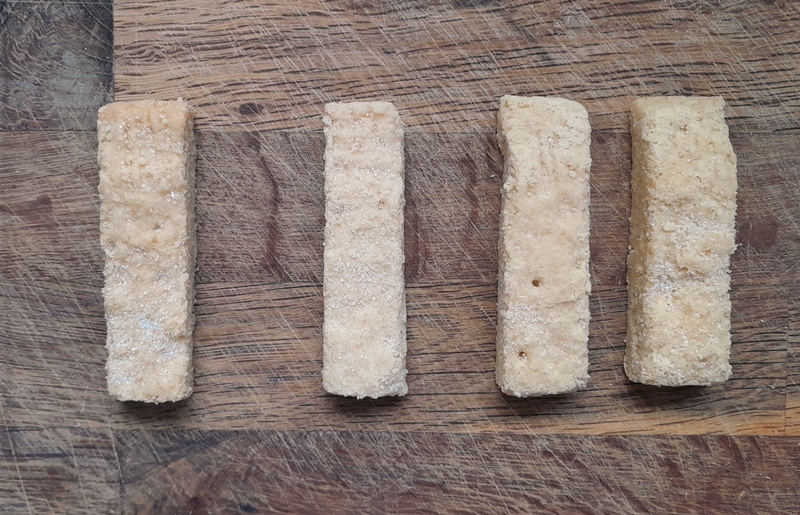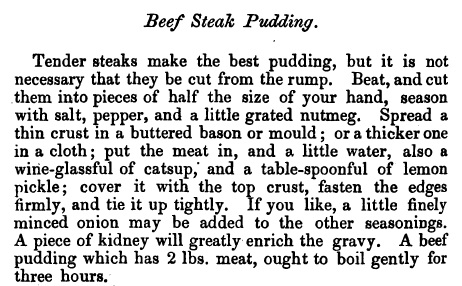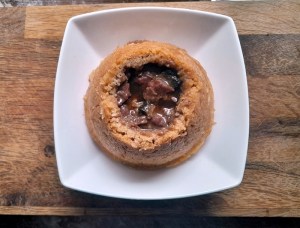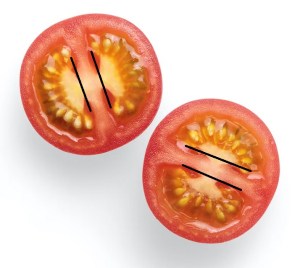I seem to be on a bit of a shortbread obsession lately, but this is the last post on it for now, promise.
Today I have for you a combination of two festive treats: Mince Pies & Shortbread.
Back in the far off days of the 1980s, I had the distinct pleasure of discovering Jocelyn Dimbleby’s “Cooking for Christmas” – a slim paperback book of recipes, produced in association with Sainsbury’s. Amongst its pages I found Deluxe Mince Pies, a version of which I have had posted over on my other blog for over 12 years now. With their orange pastry and decadent cream cheese and mincemeat filling, if you’re only going to eat one mince pie during the season, it really should be those.
However, even I will admit that they are a bit of a faff and since they are best served warm, it does limit their accessibility. So recently, whilst experimenting with the butterscotch shortbread, I got to thinking whether I could make a mincemeat version, and from there it was just a hop and a skip to re-imagining Jocelyn’s recipe.
This recipe is also an adaptation of recipes I’ve already posted on here, which I love as an example of some real Lego™ thinking, taking two different recipes and smushing them together to create something new.
The shortbread here is standing in for the mince pie pastry, so the only thing I changed was to add some orange zest. The mincemeat is an adaptation of the guilt-free mincemeat, based on Hannah Glasse’s 1747 Lenten mince pie recipe. The potential problem here was whether it would hold together on top of the shortbread, so the slight tweak I made was to increase the quantity of dates, which break down into a sweet and sticky paste during the simmering of the fruit, and firm up when cooled. I increased the spices a little, to compensate for the mincemeat being eaten cold, which tends to dull their potency. I also used an egg-white wash over the top of the shortbread, which when briefly baked forms something of a barrier to keep the moisture from the mincemeat compromising the crispness of the shortbread. Finally, I decided to top things off with white chocolate flavoured with lemon zest, to mimic the cream cheese element of the original mince pies.
Baking a slab of shortbread is a lot more straightforward than battling with pastry and filling and fretting whether the lids are sealed properly and whether the bottoms are properly cooked, etc. Bonus: you can cut your shortbread into as many pieces of whatever size you like.
Mince Pie Shortbread
The Mincemeat
You can make this several days beforehand and store in the fridge, if liked. When required, to make it easier to then spread over the shortbread, put it into a pan, cover and heat on the lowest setting. You might want to add a little more liquid (apple juice/orange juice/brandy/sherry) to help it loosen up. The additional dates add to the sweetness, so if you don’t have a sweet tooth, you might want to substitute the apple juice for the juice of an extra orange or even lemon
50g currants
50g raisins – crimson raisins look pretty
50g sultanas
200g dates – finely chopped
25g candied orange peel
25g candied lemon peel
25g candied grapefruit or citron peel
35g dried cranberries
25g slivered almonds or flaked almonds – chopped
2tbs sherry
1tbs brandy
juice & grated rind of 1 orange
¼ tsp of ground ginger
¼ tsp of nutmeg,
¼ tsp of ground cinnamon
¼ tsp of mixed spice
¼ tsp of ground cloves
60-100ml apple juice or juice of 1 orange/lemon
- Put the dried fruits into a small saucepan.
- Cut the candied peel into small pieces with scissors and add to the pan with the spices. NB If you’re using your home-made candied peel that has been stored in syrup, then there’s no need to soften it in the saucepan – just stir it in with the nuts once the fruit has plumped.
- Add the orange juice and zest, brandy, sherry and 60ml of apple juice (or the extra orange/lemon juice).
- Stir gently to combine and set pan over the lowest possible heat.
- Cover and let the mixture stew gently until all the liquid has been absorbed.
- If the fruit isn’t as plumped and juicy as you would like, add a little more liquid.
- The mixture should be moist, but with no liquid visible in the bottom.
- When you’re happy with the consistency, stir through the almonds.
The Shortbread
Make whichever shortbread variation you prefer, regular or gluten-free.
60g soft brown sugar
120g unsalted butter, chilled
180g plain flour – or gluten-free flour
60g your choice of additional flour (rice flour, cornflour, cornmeal, semolina, etc)
¼ tsp salt
zest of 1-2 oranges, depending on size
1 egg-white for glazing
- Line a small baking tin (18cm x 25cm) with baking parchment. Leave extra parchment overlapping the sides, to assist in moving the baked shortbread.
- Heat the oven to 160°C, 140°C Fan.
- Cut the butter into cubes and add to the bowl of a food processor fitted with a blade.
- Add the remaining dry ingredients and zest to the butter and pulse briefly until the mixture resembles breadcrumbs.
- Tip the mixture onto the parchment, and press into an even layer.
- Use a round skewer or cocktail stick to poke holes all over the surface of the slab of shortbread.
- Bake the shortbread for 30 minutes, turning the tin around after 15 minutes to ensure even baking.
- Once the shortbread is baked,
- Remove the shortbread from the oven. Keep the oven on.
- Whisk the egg white until frothy, then paint a layer onto the hot shortbread and return it to the oven for 3 minutes to set.
- Remove the tin from the oven, switch off the heat and using a very thin bladed knife or (ideally, in my opinion) a metal dough scraper, cut the shortbread into pieces. I cut mine lengthwise in half, then across into fingers 2-3cm wide.
- Return the tin to the cooling oven to cool.
The Topping
250g white chocolate
zest from 1 lemon
- Break the chocolate into pieces and melt in a bowl either over simmering water, or by zapping in the microwave in short bursts.
- Stir through the lemon zest.
To Assemble
- Spread a layer of mincemeat over the cooled shortbread. I didn’t use all of the batch, only about 2/3, but if you’d prefer a thicker layer, have at it by all means.
- Smooth over the top with a palette knife or similar.
- Pour over the lemon-flavoured white chocolate and smooth over.
- Put it in the fridge to set (optional – you can leave it on the worktop if you have the room).
To Divide
In a repeat of the instructions from Butterscotch Shortbread, here is how to ensure your slab of mince pie shortbread emerges in sharp and clean slices.
- When you’re ready to portion it out, remove your slab of mince pie shortbread from the fridge and set it on the countertop. Leave it to come to room temperature. Trying to cut through the chocolate layer whilst chilled will just shatter it. If your shortbread cooled on the worktop, you can, if course, skip this step.
- Take a clean cloth or a double layer of kitchen roll and lay it on top of the set chocolate.
- Lay a cutting board on top of that, and carefully turn the whole slab over, so that once the tin and the baking parchment are removed, the shortbread is uppermost.
- The lines from cutting the shortbread earlier should be clearly visible.
- Slide your dough blade into the cuts in the shortbread, then press down sharply to cut through both the mincemeat and the chocolate layers in one clean movement.
- Make sure you have cut – or rather re-cut – through all of the pieces before trying to move your mince pie shortbread.
- Store your shortbread in an airtight container. Use a piece of parchment between layers to keep crumbs off your pristine chocolate finish.




















